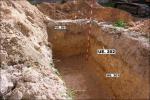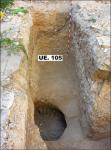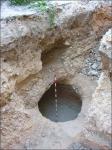Summary (English)
Due to the excavation of the site on 39, Francisco Candela street of this town, it was possible to rule out the continuation of the Moorish necropolis of El Raval, previously found some 86 metres to the north on 17-19, Santa Anastasia Street, n.17-19 and Higueras Street. During the excavation, using three mechanical probes, only one negative structure was found. This is a silo of the Islamic period excavated in the sterile substrate and found in Sondage 1.
The three sondages have a similar stratigraphy which is only truncated by the apparition of the silo in Sondage 1. Apart from this exception, we found a floor of hydraulic tiles under which lies a layer of abundant gypsum used to stabilise the earth and settle the floor.
Under this level from the modern period, there is a dark brown stratum which gets darker the further south one goes. This stratum has also been dated in the modern period following the study of thematerial.Beneath it there is a sterile substratum which, in the case of Probe 1, is cut off by the granary of the EU 4001. This structure seems to have been reused ultimately as a landfill.
The archaeological material extracted from the silo has been dated in the Almohad period (1150-1250),specifically the 13th century, given that the presence of jugs dated in this century.. The pottery is very fragmentary and its dimensions are reduced, but some sherds of vases painted with manganese oxide stand out.The area of the intervention is located one block north of the limit of the urban zone of the Islamic city. That is to say, it is situated just outside the suburbs of the medina, very close to it. The layout of the Islamic city has been observed due to the continuing archaeological excavations and the evidence of the written sources, although the time of its foundation is unknown.
Based on these data, we find a landfill from the Islamic era which was probably associated with some kind of small-scale housing structure, located very close to the medina but in its outer region. The absence of walls stops us from linking the silo with some kind of specific construction, although it seems possible that this would be in an agricultural facility.
(translation by Alex Redmond)
- Inmaculada Reina Gómez
Director
- Francisco A. Molina Mas e Inmaculada Reina Gómez (ARPA Patrimonio, S.L.)
Team
- Antonio Martínez Castelló, Ana Alegre López, Rosa Ma López Martínez y Samuel Serrano Salar
- Museo Arqueológico Municipal de Crevillente
Research Body
- Diputación Provincial de Alicante
Funding Body
- Mª Teresa García Guillén






![Download [PDF]](/excavation/skins/fasti/images/results/download_sml.png)

